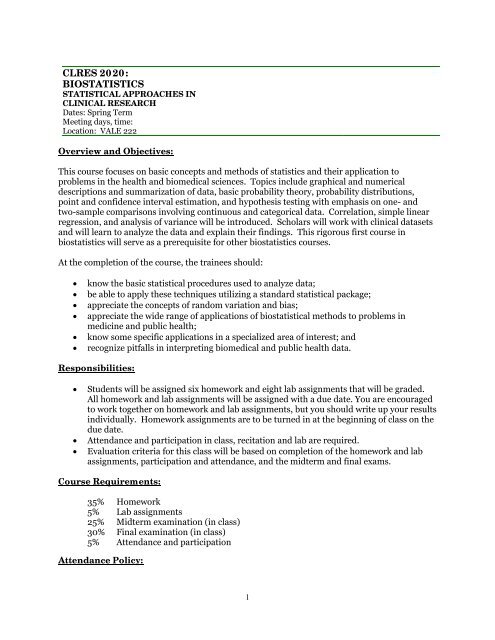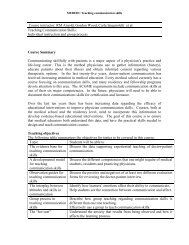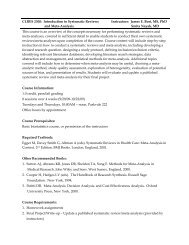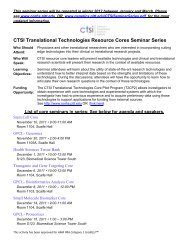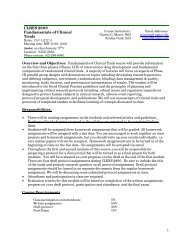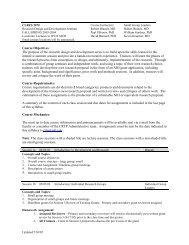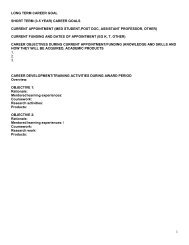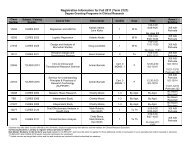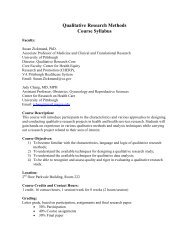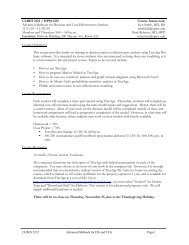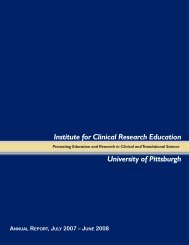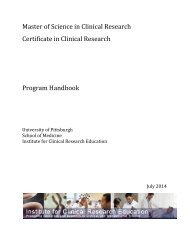CLRES 2020: BIOSTATISTICS - University of Pittsburgh
CLRES 2020: BIOSTATISTICS - University of Pittsburgh
CLRES 2020: BIOSTATISTICS - University of Pittsburgh
Create successful ePaper yourself
Turn your PDF publications into a flip-book with our unique Google optimized e-Paper software.
<strong>CLRES</strong> <strong>2020</strong>:<br />
<strong>BIOSTATISTICS</strong><br />
STATISTICAL APPROACHES IN<br />
CLINICAL RESEARCH<br />
Dates: Spring Term<br />
Meeting days, time:<br />
Location: VALE 222<br />
Overview and Objectives:<br />
This course focuses on basic concepts and methods <strong>of</strong> statistics and their application to<br />
problems in the health and biomedical sciences. Topics include graphical and numerical<br />
descriptions and summarization <strong>of</strong> data, basic probability theory, probability distributions,<br />
point and confidence interval estimation, and hypothesis testing with emphasis on one- and<br />
two-sample comparisons involving continuous and categorical data. Correlation, simple linear<br />
regression, and analysis <strong>of</strong> variance will be introduced. Scholars will work with clinical datasets<br />
and will learn to analyze the data and explain their findings. This rigorous first course in<br />
biostatistics will serve as a prerequisite for other biostatistics courses.<br />
At the completion <strong>of</strong> the course, the trainees should:<br />
• know the basic statistical procedures used to analyze data;<br />
• be able to apply these techniques utilizing a standard statistical package;<br />
• appreciate the concepts <strong>of</strong> random variation and bias;<br />
• appreciate the wide range <strong>of</strong> applications <strong>of</strong> biostatistical methods to problems in<br />
medicine and public health;<br />
• know some specific applications in a specialized area <strong>of</strong> interest; and<br />
• recognize pitfalls in interpreting biomedical and public health data.<br />
Responsibilities:<br />
• Students will be assigned six homework and eight lab assignments that will be graded.<br />
All homework and lab assignments will be assigned with a due date. You are encouraged<br />
to work together on homework and lab assignments, but you should write up your results<br />
individually. Homework assignments are to be turned in at the beginning <strong>of</strong> class on the<br />
due date.<br />
• Attendance and participation in class, recitation and lab are required.<br />
• Evaluation criteria for this class will be based on completion <strong>of</strong> the homework and lab<br />
assignments, participation and attendance, and the midterm and final exams.<br />
Course Requirements:<br />
35% Homework<br />
5% Lab assignments<br />
25% Midterm examination (in class)<br />
30% Final examination (in class)<br />
5% Attendance and participation<br />
Attendance Policy:<br />
1
• Students are expected to sign-in to each class, lab and recitation (computer provided in<br />
suite lobby). If a problem is encountered with the sign-in system, please contact the<br />
course instructor(s) as well as Lauren Talotta (talottals@upmc.edu) immediately.<br />
Course Grading Scale:<br />
For the computation <strong>of</strong> the final course grade as well as for the course assignments, the<br />
following grading scale will be used:<br />
90 - 100 = A 80 – 85 = B 70 – 75 = C 60 – 65 = D<br />
86 – 89 = B+ 76 – 79 = C+ 66 – 69 = D+ < 60 = F<br />
NOTE: Homework assignments, course information, and communication will be available at<br />
http://courseweb.pitt.edu.<br />
Required Textbook(s):<br />
Rosner B (2010). Fundamentals <strong>of</strong> Biostatistics, 7th Edition. Duxbury Press, Pacific<br />
Grove, CA.<br />
Supplemental Textbook(s):<br />
• Rosner B (2000). Study Guide for Fundamentals <strong>of</strong> Biostatistics. Duxbury Press,<br />
Pacific Grove, CA.<br />
• Glover TJ and Mitchell KJ (2002). An Introduction to Biostatistics. McGraw-Hill,<br />
New York.<br />
• Fisher LD and van Belle G (1993). Biostatistics: A Methodology for the Health<br />
Sciences. Wiley, New York.<br />
Computer package:<br />
STATA<br />
Academic Integrity:<br />
Students in this course will be expected to comply with the <strong>University</strong> <strong>of</strong> <strong>Pittsburgh</strong>'s Policy on<br />
Academic Integrity (http://www.provost.pitt.edu/info/ai1.html). Any student suspected <strong>of</strong><br />
violating this obligation for any reason during the semester will be required to participate in the<br />
procedural process, initiated at the instructor level, as outlined in the <strong>University</strong> Guidelines on<br />
Academic Integrity. This may include, but is not limited to, the confiscation <strong>of</strong> the examination<br />
<strong>of</strong> any individual suspected <strong>of</strong> violating <strong>University</strong> Policy. Furthermore, no student may bring<br />
any unauthorized materials to an exam, including dictionaries and programmable calculators.<br />
Disabilities:<br />
If you have a disability that requires special testing accommodations or other classroom<br />
modifications, you need to notify both the instructors and the Disability Resources and Services<br />
no later than the 2nd week <strong>of</strong> the term. You may be asked to provide documentation <strong>of</strong> your<br />
disability to determine the appropriateness <strong>of</strong> accommodations. To notify Disability Resources<br />
2
and Services, call 412-648-7890 (Voice or TTD) to schedule an appointment. The Office is<br />
located in 216 William Pitt Union.<br />
Copyright notice:<br />
These materials may be protected by copyright. United States copyright law, 17 USC section 101,<br />
et seq., in addition to <strong>University</strong> policy and procedures, prohibit unauthorized duplication or<br />
retransmission <strong>of</strong> course materials. See Library <strong>of</strong> Congress Copyright Office and the <strong>University</strong><br />
Copyright Policy.<br />
Other links:<br />
• <strong>CLRES</strong> 2005: Computer Based Data Analyses<br />
• Clinical Research Training Program<br />
• <strong>University</strong> <strong>of</strong> <strong>Pittsburgh</strong><br />
3
Course Schedule<br />
Session 1: Introduction to Biostatistics<br />
At the conclusion <strong>of</strong> this lecture, the student will be able to:<br />
Topics:<br />
1. Understand basic concepts <strong>of</strong> statistics<br />
2. Describe data using numerical and graphical summaries<br />
1. Course overview<br />
2. Introduction to basic concepts <strong>of</strong> statistics<br />
3. Descriptive statistics<br />
Required Reading:<br />
• Rosner’s Book Chapter 1-2<br />
Session 2: Probability (I)<br />
At the conclusion <strong>of</strong> this lecture, the student will be able to:<br />
Topics:<br />
1. Understand basic concepts <strong>of</strong> probability<br />
2. Use probability rules/laws to solve problems<br />
1. Simple examples and definitions<br />
2. Probability Rules<br />
3. The addition law <strong>of</strong> probability<br />
4. The multiplication law <strong>of</strong> probability<br />
Required Reading:<br />
• Rosner’s Book Chapter 3<br />
Session 3: Probability (II)<br />
At the conclusion <strong>of</strong> this lecture, the student will be able to:<br />
1. Understand basic concepts <strong>of</strong> probability and screening test<br />
2. Use probability rules/laws to solve problems<br />
Topics:<br />
1. Conditional Probability<br />
2. Total Probability Rule<br />
3. Bayes’ Rule and Screening Tests<br />
Required Reading:<br />
4
• Rosner’s Book Chapter 3<br />
Homework assignment 1:<br />
1. Describe the data with numerical and graphical summaries.<br />
2. Probability question<br />
3. Screening test<br />
Session 4: Discrete Probability Distribution<br />
At the conclusion <strong>of</strong> this lecture, the student will be able to:<br />
Topics:<br />
1. Understand concepts <strong>of</strong> random variable and its distribution<br />
2. Calculate the mean and variance <strong>of</strong> binomial and poisson distribution<br />
3. Familiar with PMF and CDF <strong>of</strong> binomial and poisson distribution<br />
4. Distinguish between binomial and poisson distribution<br />
1. Definition <strong>of</strong> a Random Variable<br />
2. The Probability Mass Function (Probability Function; Distribution)<br />
3. The Expected value <strong>of</strong> a discrete random variable<br />
4. The Variance <strong>of</strong> a discrete random variable<br />
5. The Cumulative Distribution Function<br />
6. The Binomial Distribution<br />
7. The Poisson Distribution<br />
Required Reading:<br />
• Rosner’s Book Chapter 4<br />
Session 5: Continuous Probability Distributions (I)<br />
At the conclusion <strong>of</strong> this lecture, the student will be able to:<br />
Topics:<br />
1. Calculate the expected value and variance <strong>of</strong> continuous random variable<br />
2. Familiar with PDF and CDF <strong>of</strong> normal distribution<br />
3. Use normal tables to solve problems<br />
1. Definition <strong>of</strong> Random Variables (Review)<br />
2. Probability Density Function<br />
3. The Cumulative Distribution Function<br />
4. The Expected Value and the Variance <strong>of</strong> a Continuous Random Variable<br />
5. The Normal Distribution<br />
6. Using Normal Tables<br />
Required Reading:<br />
5
1. Rosner’s Book Chapter 5<br />
Homework assignment 2:<br />
1. Binomial distribution<br />
2. Poisson distribution<br />
3. Normal distribution<br />
Session 6: Continuous Probability Distributions (II)<br />
At the conclusion <strong>of</strong> this lecture, the student will be able to:<br />
Topics:<br />
1. Transfer any normal distribution to standard normal distribution<br />
2. Calculate probability <strong>of</strong> discrete distribution using normal approximation<br />
3. Understand concepts and theorems <strong>of</strong> sampling distributions<br />
1. More on the normal distribution<br />
2. Conversion from N(µ, σ 2 ) to N(0, 1)<br />
3. Applications to probability calculations<br />
4. Normal approximations<br />
5. Concept <strong>of</strong> sampling distributions<br />
6. The Central Limit Theorem<br />
7. The Law <strong>of</strong> Large Numbers<br />
8. Bias versus variance<br />
Required Reading:<br />
• Rosner’s Book Chapter 5-6<br />
Due Today: Homework assignment 1<br />
Session 7: Estimation<br />
At the conclusion <strong>of</strong> this lecture, the student will be able to:<br />
Topics:<br />
1. Understand concepts <strong>of</strong> sampling distribution<br />
2. Estimate the population mean and variance from a sample<br />
1. Sampling distribution <strong>of</strong> an estimator<br />
2. The central limit theorem<br />
3. Sampling distribution <strong>of</strong> the sample mean<br />
4. Point and interval estimation <strong>of</strong> population mean<br />
5. Factors affecting the length <strong>of</strong> a CI<br />
6. Sampling distribution <strong>of</strong> the sample variance<br />
7. Point and interval estimation <strong>of</strong> population variance<br />
Required Reading:<br />
6
• Rosner’s Book Chapter 6<br />
Session 8 & 9: Midterm review<br />
At the conclusion <strong>of</strong> this lecture, the student will be able to:<br />
Topics:<br />
1. Familiar with descriptive statistics<br />
2. Probability rules and screening test<br />
3. Discrete distribution (binomial and poisson)<br />
4. Continuous distribution (normal distribution)<br />
Review lectures 1-6<br />
Required Reading:<br />
• Rosner’s Book Chapter 1-6<br />
Homework assignment 3:<br />
1. Standardize normal distribution<br />
2. Normal approximation for poisson distribution<br />
3. Normal approximation for binomial distribution<br />
Session 10: Midterm exam<br />
Topics:<br />
Midterm exam<br />
Due Today: Homework assignment 2<br />
Session 11: One-sample inference<br />
At the conclusion <strong>of</strong> this lecture, the student will be able to:<br />
Topics:<br />
1. Set up null and alternative hypotheses for significance tests<br />
2. Interpret p values<br />
3. Understand type I and type II error<br />
4. Make inference based on one-sample t test<br />
1. Significance tests-the general concepts<br />
2. Steps in hypothesis testing<br />
3. Type I and Type II error<br />
4. Test statistics and p value<br />
5. One-sample t tests<br />
7
Required Reading:<br />
• Rosner’s Book Chapter 7<br />
Homework assignment 4:<br />
1. Confidence interval estimate for population mean and variance<br />
2. One sample t test<br />
3. Two sample t test<br />
Session 12: Two-sample inference<br />
At the conclusion <strong>of</strong> this lecture, the student will be able to:<br />
Topics:<br />
1. Make inference based on two-sample tests<br />
2. Understand the relationship between hypothesis testing and confidence interval<br />
1. Review concepts <strong>of</strong> hypothesis testing<br />
2. Two-sample F tests<br />
3. Two-sample t tests<br />
4. Paired t tests<br />
5. Hypothesis testing vs. confidence interval<br />
Required Reading:<br />
• Rosner’s Book Chapter 8<br />
Due Today: Homework assignment 3<br />
Session 13: Analysis <strong>of</strong> Variance<br />
At the conclusion <strong>of</strong> this lecture, the student will be able to:<br />
Topics:<br />
1. Test equal means among more than 2 groups using one-way ANOVA<br />
2. Check assumptions for ANOVA<br />
3. Adjust for multiple comparisons<br />
1. Basic idea <strong>of</strong> analysis <strong>of</strong> variance<br />
2. The hypotheses and assumptions<br />
3. ANOVA table<br />
4. Bartlett’s test <strong>of</strong> homogeneity <strong>of</strong> variance<br />
5. Post-hoc procedure (Multiple comparisons)<br />
Required Reading:<br />
• Rosner’s Book Chapter 12<br />
Session 14: Nonparametric statistics<br />
8
At the conclusion <strong>of</strong> this lecture, the student will be able to:<br />
Topics:<br />
1. Understand when nonparametric tests were necessary<br />
2. Carry out proper nonparametric tests when necessary<br />
1. Motivation <strong>of</strong> nonparametric tests<br />
2. Sign test<br />
3. Sign rank test<br />
4. Rank-Sum test<br />
5. Kruskal-Wallis test<br />
Required Reading:<br />
• Rosner’s Book Chapter 9<br />
Homework assignment 5:<br />
1. One-way ANOVA and multiple comparisons<br />
2. Sign test<br />
3. Correlation and simple linear regression<br />
Session 15: Correlation and simple linear regression (I)<br />
At the conclusion <strong>of</strong> this lecture, the student will be able to:<br />
1. Measure association between two continous variables<br />
2. Fit and interpret simple linear regression models<br />
Topics:<br />
1. Correlation coefficients<br />
2. Simple linear regression<br />
3. Parameter estimation<br />
4. Hypothesis testing<br />
5. Evaluating the regression model<br />
Required Reading:<br />
• Rosner’s Book Chapter 11<br />
Due Today: Homework assignment 4<br />
Session 16: Correlation and simple linear regression (II)<br />
At the conclusion <strong>of</strong> this lecture, the student will be able to:<br />
3. Measure association between two continous variables<br />
4. Fit and interpret simple linear regression models<br />
Topics:<br />
6. Correlation coefficients<br />
7. Simple linear regression<br />
9
8. Parameter estimation<br />
9. Hypothesis testing<br />
10. Evaluating the regression model<br />
Required Reading:<br />
• Rosner’s Book Chapter 11<br />
Session 17: Power & Sample size calculations<br />
At the conclusion <strong>of</strong> this lecture, the student will be able to:<br />
Topics:<br />
1. Estimate power and sample size for one and two sample Z test<br />
1. Review type I, type II error and power<br />
2. Power estimation for one-sample Z test<br />
3. Factors affecting power<br />
4. Sample size estimation for one-sample Z test<br />
5. Power and sample size estimation for two-sample Z test<br />
6. Sample-size estimation for desired margin <strong>of</strong> error<br />
Required Reading:<br />
• Rosner’s Book Chapter 13<br />
Homework assignment 6:<br />
1. Sample size estimation<br />
2. Contingency table analysis<br />
Session 18: Analysis <strong>of</strong> categorical data (I)<br />
At the conclusion <strong>of</strong> this lecture, the student will be able to:<br />
Topics:<br />
1. Test equal proportions for one or two groups <strong>of</strong> binary data<br />
2. Analysis data from contingency tables<br />
3. Analysis matched binary data<br />
4. Measure agreement between two raters<br />
1. One and two sample tests <strong>of</strong> proportions and CI<br />
2. Power and sample size estimations for proportion tests<br />
3. Chi-square and Fisher’s exact test for contingency tables<br />
4. McNemar’s test for matched binary data<br />
5. Kappa statistic for rater agreement<br />
Required Reading:<br />
• Rosner’s Book Chapter 10<br />
10
Due Today: Homework assignment 5<br />
Session 19: Analysis <strong>of</strong> categorical data (II)<br />
At the conclusion <strong>of</strong> this lecture, the student will be able to:<br />
Topics:<br />
5. Test equal proportions for one or two groups <strong>of</strong> binary data<br />
6. Analysis data from contingency tables<br />
7. Analysis matched binary data<br />
8. Measure agreement between two raters<br />
6. One and two sample tests <strong>of</strong> proportions and CI<br />
7. Power and sample size estimations for proportion tests<br />
8. Chi-square and Fisher’s exact test for contingency tables<br />
9. McNemar’s test for matched binary data<br />
10. Kappa statistic for rater agreement<br />
Required Reading:<br />
• Rosner’s Book Chapter 10<br />
Session 20: Introduction to logistic regression & survival analysis<br />
At the conclusion <strong>of</strong> this lecture, the student will be able to:<br />
Topics:<br />
1. Understand the basic ideas <strong>of</strong> logistic regression<br />
1. Basic concepts <strong>of</strong> logistic regression<br />
2. The logit transformation<br />
3. Estimation technique<br />
4. Interpretation<br />
5. Model adequacy checking<br />
6. Multinomial logistic regression<br />
Session 21: Introduction to correlated data analysis<br />
At the conclusion <strong>of</strong> this lecture, the student will be able to:<br />
Topics:<br />
1. Understand the basic ideas <strong>of</strong> survival analysis and correlated data analysis<br />
1. Nature <strong>of</strong> problems for survival analysis<br />
2. Survival or life expectancy<br />
3. Kaplan-Meier curves and actuarial survival<br />
4. Log Rank statistics<br />
5. Hazard <strong>of</strong> death<br />
6. Parametric survival regression models<br />
7. Cox proportional hazards models<br />
11
8. Methods for correlated data analysis<br />
9. Incomplete data<br />
Due Today: Homework assignment 6<br />
Session 22 & 23: Final exam review<br />
At the conclusion <strong>of</strong> this lecture, the student will be able to:<br />
Topics:<br />
1. One and two sample inference<br />
2. Analysis <strong>of</strong> variance<br />
3. Nonparametric tests<br />
4. Correlation and simple linear regression<br />
5. Power and sample size calculation<br />
6. Categorical data analysis<br />
Review lectures 10-17<br />
Required Reading:<br />
• Rosner’s Book Chapter 6-13<br />
Session 24: Final exam<br />
Topics:<br />
Final exam<br />
12


